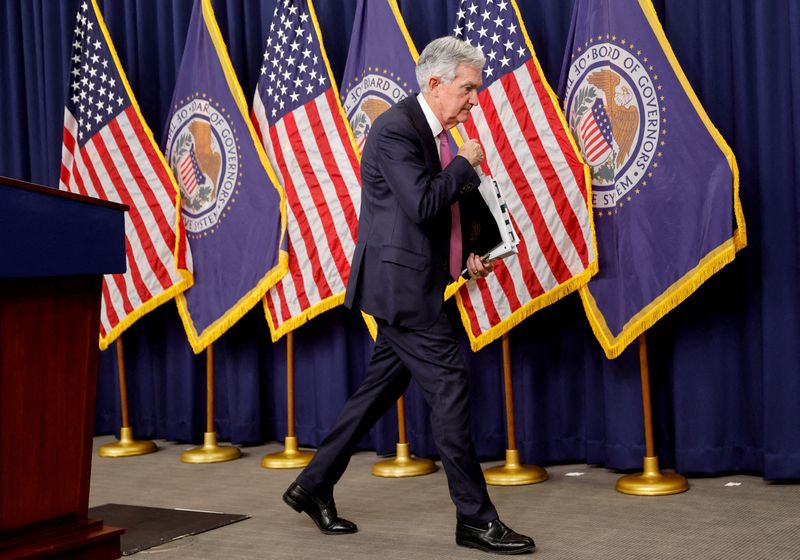By Howard Schneider
WASHINGTON (Reuters) - A blowout January employment report and continued record numbers of job openings have left the U.S. Federal Reserve with a growing dilemma of whether to take its cue about future inflation from a labor market that seems to remain on fire or take solace in the fact that, at the same time, wage growth continues to cool.
Even as firms added more than half a million jobs last month, the growth in average hourly earnings fell to 4.4% from 4.8% the month before, continuing a decline from around 6% last spring.
The dissonance in the data – continued high demand for workers coupled with some easing in wage inflation – will be a key puzzle for policymakers to resolve as they plot their next interest rate moves.
At a high level it showed the U.S. economy continuing a stunning rebound in jobs despite the ravages of the pandemic, with payroll employment now on track to return to its pre-pandemic trend level sometime his year.
For the Fed, the question is whether the economy can continue from here to the low inflation, low unemployment days seen before the coronavirus struck in 2020, or whether a continued decline in inflation will require a looser labor market and higher joblessness.
Analysts were struggling Friday to parse the underlying story, with some suggesting data and statistical revisions may be distorting the numbers, while others were seeing potentially - for the Fed - constructive dynamics at work.
Data from payroll services provider UKG showed hiring was shifting from larger to smaller firms, said UKG Vice President Dave Gilbertson, a fact that could sustain overall hiring even as it decreased competition for workers and allowed wage growth to moderate.
"Small companies struggled so hard to hire during the pandemic," Gilbertson said. "Big companies got aggressive and they are paying the price."
IMBALANCES
The Fed raised its target policy rate a quarter of a point this week to a 4.50%-4.75% range, and as of December officials projected two more such increases this year to a peak of between 5% and 5.25%.
After discounting the Fed would get that high, investors on Friday raised their expected peak interest rate to align with the Fed's outlook, which will be updated at the central bank's next meeting in March.
The stronger-than-expected hiring pushed the unemployment rate to 3.4%, the lowest since the spring of 1969.
“It will give the Fed absolutely no reassurance that labor market imbalances – which have been adding to wage pressures - are easing," said Brian Coulton, chief economist at Fitch Ratings. "It will reinforce the message that the Fed still has quite a lot of work to do to tame core inflation."
Still, a U.S. labor force that had flatlined through much of last year has grown by 1.3 million in the past two months. That might alleviate an aggravating factor for both employers and policymakers who saw the work force's stagnation as contributing to last year's outsized wage gains.
U.S. Labor Secretary Martin Walsh said he thought Friday's report showed signs of an economy and labor market steadily returning to normal.
People “are settling in after two years of jumping around from job to job. They are moving into careers,” Walsh said. “I think you’ll see more of that as we move forward.”
Meanwhile, Inflation Insights President Omair Sharif attributed much of the seeming moderation in wage growth to the fact that prior months were revised higher as part of the Labor Department's annual benchmark revision process reflected in the report for each January. On an annualized three-month basis, he noted, wages rose more as of January than as of October.
HEADING BACK TO 2019?
But there were other interpretations.
Fed Chair Jerome Powell at his press conference following the Fed's meeting this week agreed that more rate hikes would be needed to bring inflation back into line with the central bank's 2% target, that the job market remained out of balance, and that wage growth probably needed to cool further particularly in the service sector.
Yet he also noted that a process of "disinflation" had taken root in the United States and that growth in wage and employment costs were slowing - all so far without any damage to hiring or jobs.
Powell pointed out that the years just before the COVID-19 health crisis included simultaneously low unemployment, low inflation, and sustainably modest wage growth, proof that a best-case set of conditions was achievable.
"I continue to think that there's a path to getting inflation back down to 2% without a really significant economic decline or a significant increase in unemployment," Powell said Wednesday.

If sustained, current wage, price and hiring trends are heading back in that direction.
While raising the odds of rate hikes, "it will be interesting to see how the Fed parses slowing wage and price data going forward with a very healthy labor market," wrote III Capital Management Chief Economist Karim Basta. "Are we heading back to 2019?"